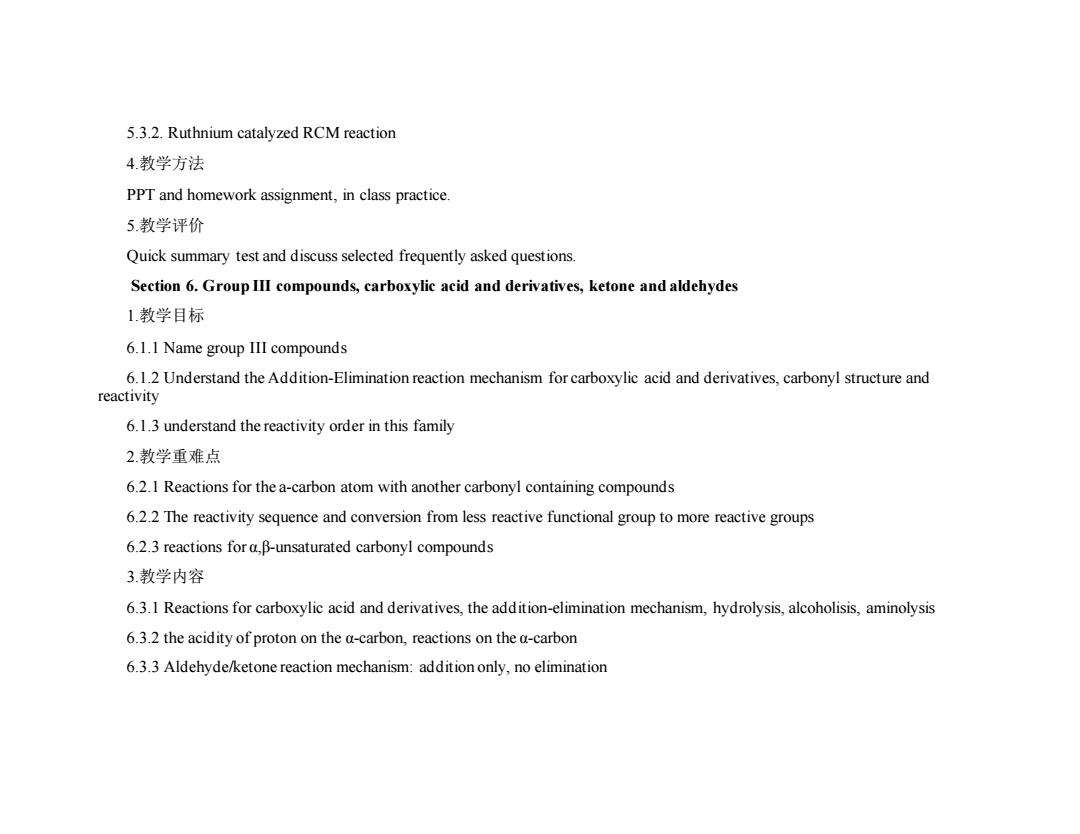
4.2.1 Radical mechanism as indicating by single electron flow 4.2.2 Radical substitution mechanism 4.2.3 Radical addition mechanism for this group of compounds 3.教学内容 4.3.1 Nomenclature of saturated hydrocarbons 4.3.2 Radical substitution reaction between saturated hydrocarbons and chlorine and bromines. 4.3.3 Radical addition reactions between double bond containing hydrocarbons and NBS 4.教学方法 Based on the introduction of case study,improve the student understanding factors including physicochemical and physiological characteristics that influence drug performance in vivo and in vitro 5.教学评价 PPT in combination with blackboard drawing,in class quiz.2nd term exam content Section 5.Organometallic compounds 1.教学目标 5.1.1 Students are expected to understand the carbon-carbon bond formation using metal as catalyst. 5.1.2 provide the correct product when substrates are given 2.教学重难点 5.2.1 The carbon-carbon bond formation between sp3/sp2 carbon,sp2/sp2 hybrid ized carbon in the presence of platinium 3.教学内容 5.3.1 Heck and Suzuki reaction
4.2.1 Radical mechanism as indicating by single electron flow 4.2.2 Radical substitution mechanism 4.2.3 Radical addition mechanism for this group of compounds 3.教学内容 4.3.1 Nomenclature of saturated hydrocarbons 4.3.2 Radical substitution reaction between saturated hydrocarbons and chlorine and bromines. 4.3.3 Radical addition reactions between double bond containing hydrocarbons and NBS 4.教学方法 Based on the introduction of case study, improve the student understanding factors including physicochemical and physiological characteristics that influence drug performance in vivo and in vitro 5.教学评价 PPT in combination with blackboard drawing, in class quiz. 2nd term exam content Section 5. Organometallic compounds 1.教学目标 5.1.1 Students are expected to understand the carbon-carbon bond formation using metal as catalyst. 5.1.2 provide the correct product when substrates are given 2.教学重难点 5.2.1 The carbon-carbon bond formation between sp3/sp2 carbon, sp2/sp2 hybridized carbon in the presence of platinium 3.教学内容 5.3.1 Heck and Suzuki reaction

5.3.2.Ruthnium catalyzed RCM reaction 4.教学方法 PPT and homework assignment,in class practice. 5.教学评价 Quick summary test and discuss selected frequently asked questions Section 6.Group III compounds,carboxylic acid and derivatives,ketone and aldehydes 1.教学目标 6.1.1 Name group III compounds 6.1.2 Understand the Addition-Elimination reaction mechanism for carboxylic acid and derivatives,carbonyl structure and reactivity 6.1.3 understand the reactivity order in this family 2.教学重难点 6.2.1 Reactions for the a-carbon atom with another carbonyl containing compounds 6.2.2 The reactivity sequence and conversion from less reactive functional group to more reactive groups 6.2.3 reactions for a,B-unsaturated carbonyl compounds 3.教学内容 6.3.1 Reactions for carboxylic acid and derivatives,the addition-elimination mechanism,hydrolysis,alcoholisis,aminolysis 6.3.2 the acidity of proton on the a-carbon,reactions on the a-carbon 6.3.3 Aldehyde/ketone reaction mechanism:addition only,no elimination
5.3.2. Ruthnium catalyzed RCM reaction 4.教学方法 PPT and homework assignment, in class practice. 5.教学评价 Quick summary test and discuss selected frequently asked questions. Section 6. Group III compounds, carboxylic acid and derivatives, ketone and aldehydes 1.教学目标 6.1.1 Name group III compounds 6.1.2 Understand the Addition-Elimination reaction mechanism for carboxylic acid and derivatives, carbonyl structure and reactivity 6.1.3 understand the reactivity order in this family 2.教学重难点 6.2.1 Reactions for the a-carbon atom with another carbonyl containing compounds 6.2.2 The reactivity sequence and conversion from less reactive functional group to more reactive groups 6.2.3 reactions for α,β-unsaturated carbonyl compounds 3.教学内容 6.3.1 Reactions for carboxylic acid and derivatives, the addition-elimination mechanism, hydrolysis, alcoholisis, aminolysis 6.3.2 the acidity of proton on the α-carbon, reactions on the α-carbon 6.3.3 Aldehyde/ketone reaction mechanism: addition only, no elimination